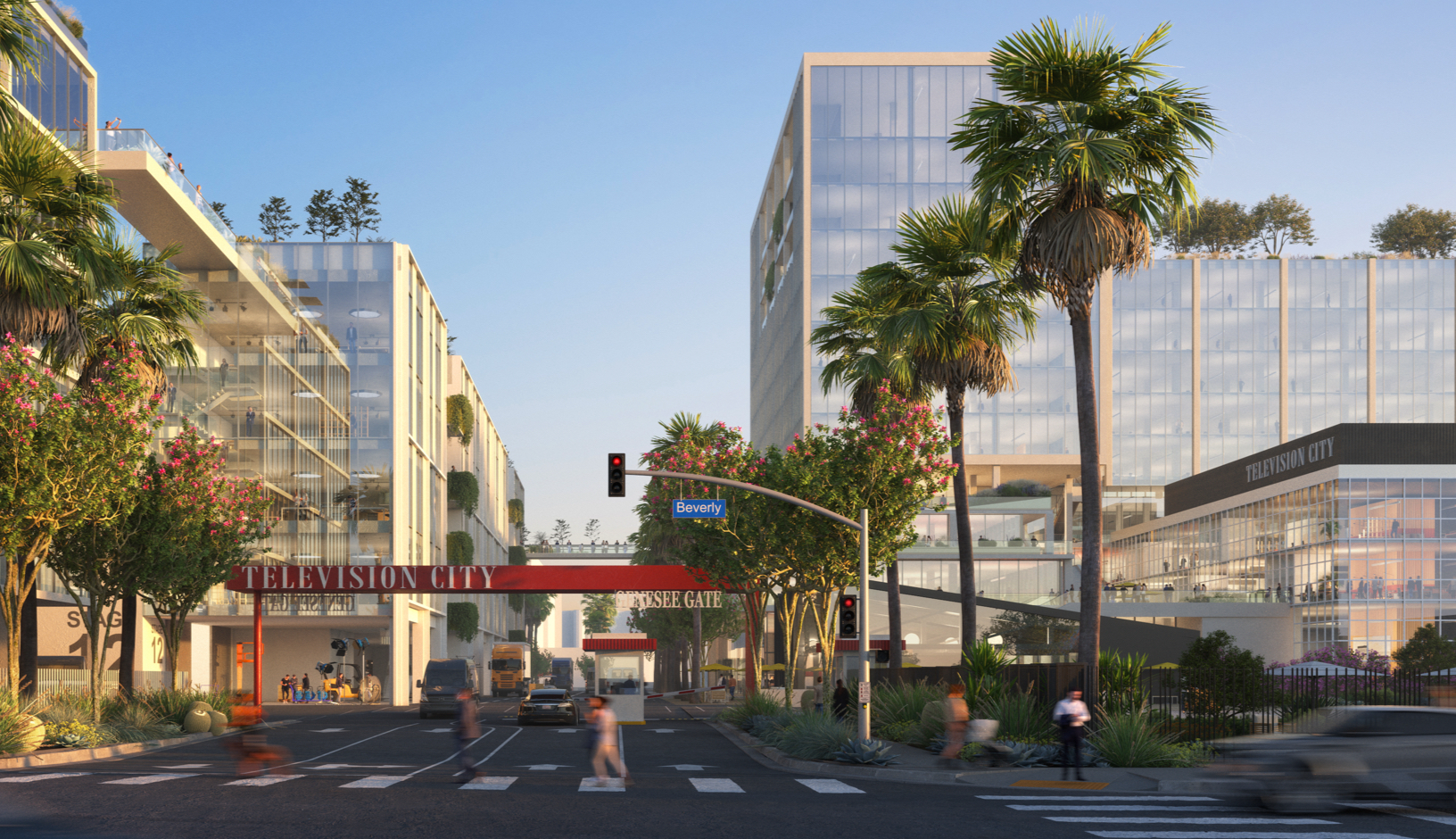
Courtesy of Roger Vincent, the Los Angeles Times.
CBS Television City opened in 1952 at the height of Los Angeles’ identity as a TV production factory. Now, one of L.A.’s most storied studios is on track to get bigger.
Owner Hackman Capital Partners plans about $1.25 billion worth of improvements to the landmark production facility, known simply as Television City these days, to feed the enormous appetite of streaming services and visual effects whizzes.
Demand for soundstages has grown in Southern California to the point where shortages keep the region’s existing stages booked year-round. Local stages have remained leased during the pandemic, even though location shoots dwindled to a trickle before mounting a comeback in recent days.
Technological advances used in making movies and television shows are creating more demand for soundstages, studio owner Michael Hackman said, as increasingly sophisticated visual effects reduce the need to shoot on locations outside a studio.
“Instead of having to take that show on the road to locations around the world to get the backgrounds, now with LED video walls they can do this all on a soundstage,” he said. “Rapidly advancing technology is creating even greater demand for soundstages.”
Hackman’s company Hackman Capital Partners is one of the world’s largest providers of entertainment production facilities as the owner of four studios in the Los Angeles region, along with studios in New York, New Orleans and London.
A subsidiary of the company bought Television City for $750 million in early 2019. The seller, CBS Corp., agreed to remain on the site as a tenant because its studios’ headquarters for its international operations are there.
CBS shows “The Late Late Show With James Corden,” “The Price Is Right” and “The Young and the Restless” are recorded there along with other broadcast fare including “Dancing With the Stars,” “American Idol” and “Real Time With Bill Mahr.”
Hackman Capital will apply Friday for city approval to redevelop the 25-acre site at Beverly Boulevard and Fairfax Avenue, next to popular tourist attractions Farmers Market and the Grove shopping center.
The owner’s proposal calls for raising the number of stages to at least 15, from 8, along with production support facilities and offices for rent.
To make room for the planned net addition of more than 1 million square feet, parking would be converted from surface lots to garage structures capable of parking 5,300 vehicles. Two stages built in the 1990s on the east side of the lot would be razed as part of a planned reconfiguration of the site.
The four original stages built by CBS in 1952 would be preserved along with other historical design elements created by Los Angeles architect William Pereira, who also designed such noteworthy structures as the futuristic Theme Building in the middle of Los Angeles International Airport and the Transamerica Pyramid office tower in San Francisco.
Pereira’s long-range plan for Television City was expansive, said Bob Hale, creative director of Rios Inc., the master plan architect of Hackman Capital’s proposed makeover. Pereira envisioned the complex would grow to 24 stages and 2.5 million square feet of production space, including several multistory office buildings, Hale said.
“It was built in a way that it could be disassembled and incrementally extended,” Hale said. “For a number of reasons, that didn’t happen.”
Hackman Capital hopes to make it happen now. In addition to the soundstages, the company’s proposal calls for combining old and new space to create 700,000 square feet of offices to support production on the lot and another 700,000 square feet of offices for rent to entertainment companies, the company said.
Office space behind studio gates is in high demand in the Los Angeles area and has been snapped up at other studios by such big Hollywood players as Netflix and Amazon.
Plans for Television City also call for a new commissary and more than four acres for production base camps. The streetscapes would also be improved to be more visually appealing to passersby.
If approved, a process that typically takes at least 18 months, construction could be completed in about two years, the company said.
When CBS put the lot on the market it was viewed by some as a likely site for a mixed-use complex of housing, hotels, offices and shopping. Hackman is betting that its status as the studio closest to the center of the region’s Thirty Mile Zone — the radius of the historic Hollywood studio area, it figures in union pay and benefit calculations — will keep Television City in its long-held role.
FilmLA President Paul Audley recently pointed to the lack of studio space as one of the reasons for a surprising 6% drop in location filming last year in the city and county of Los Angeles.
“The unions tell us everybody is working, so it’s not ‘the sky is falling,’ but the truth of it is we could do more and do better and probably see those numbers crawl back up to the highest levels … if we had space,” Audley told The Times. FilmLA has estimated a 96% occupancy rate for soundstages in Los Angeles.
Rental rates for soundstages have been increasing and big players such as streaming services have been locking in long-term leases instead of booking stages project by project as was common in the past, said real estate broker Carl Muhlstein of JLL, who specializes in entertainment properties.
It’s difficult to find places to build new soundstages in the L.A. area, he said, because stage developers find themselves competing with e-commerce operators “for every last large site.”
Television City has played an important role in CBS’ history and American pop culture as home to many legendary TV shows. It is where entertainers such as Jack Benny, Judy Garland and the cast of “All in the Family” performed.
Television City’s rectangular building’s midcentury design was made exclusively for television production and contains soundstages, editing rooms, studios and rehearsal halls.
For local residents, the structure also is a nostalgic spot, with the iconic CBS logo etched in large print on the front, visible from blocks away.
Read the story in the Los Angeles Times.

